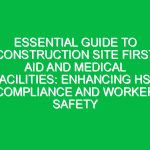In the realm of Health Safety and Environment (HSE) practices, ensuring the safety of workers who operate on scaffolding and work platforms is paramount. The construction and maintenance industries, in particular, often require tasks to be performed at heights, which inherently come with increased risks. However, with the right knowledge, tools, and adherence to safety protocols, these risks can be significantly minimized. This article delves into expert tips and best practices for the safe use of scaffolding and work platforms, aiming to foster a safer working environment for all.
Understanding the Basics of Scaffolding and Work Platform Safety
Before we dive into the specifics, it’s crucial to understand what scaffolding and work platforms are. Scaffolding is a temporary structure used to support workers and materials during the construction, maintenance, or repair of buildings and other structures. Work platforms, on the other hand, include a variety of equipment such as aerial lifts and elevated platforms designed to lift workers to necessary heights.
Both scaffolding and work platforms are indispensable in the HSE domain, but their safe use is non-negotiable. Let’s explore how to achieve this.
Key Safety Tips for Scaffolding and Work Platforms
1. Comprehensive Training
One of the foundational steps in ensuring safety is providing comprehensive training for all workers who will be using scaffolding and work platforms. This training should cover the correct setup and dismantling procedures, how to safely ascend and descend, and how to conduct thorough inspections of the equipment before use.
2. Regular Inspections
Both scaffolding and work platforms must be inspected regularly to ensure they are in good working condition and safe to use. These inspections should be carried out by competent persons who are trained to identify potential hazards, such as structural weaknesses, missing components, or wear and tear that could compromise safety.
3. Adherence to Load Capacities
Overloading scaffolding or work platforms is a common cause of accidents. It’s essential to adhere strictly to the load capacities specified by the manufacturers. This includes not only the weight of the workers but also any tools, materials, or equipment that may be used or stored on the platform.
4. Proper Use of Personal Protective Equipment (PPE)
Personal Protective Equipment (PPE) is a critical component of worker safety when using scaffolding and work platforms. Depending on the specific situation, this may include hard hats, safety harnesses, gloves, and non-slip footwear. Ensuring that all workers are equipped with and correctly use PPE can significantly reduce the risk of injuries.
5. Implementing Fall Protection Measures
Fall protection measures are essential when working at heights. This can include guardrails, safety nets, or personal fall arrest systems. It’s crucial to assess the specific risks associated with each task and implement the appropriate fall protection measures to protect workers.
Advanced Practices for Enhanced Safety
1. Emergency Preparedness
Despite all precautions, emergencies can still occur. Therefore, having a well-thought-out emergency response plan is crucial. This plan should include procedures for rescuing workers from heights, medical treatment for injuries, and evacuation in case of structural failure or other hazards.
2. Weather Considerations
Weather conditions can significantly impact the safety of scaffolding and work platforms. High winds, rain, snow, or ice can all create hazardous conditions. It’s important to monitor weather forecasts and adjust work schedules or take additional safety measures as necessary.
3. Clear Communication Channels
Clear and effective communication is vital for the safe operation of scaffolding and work platforms. Workers should be trained in the use of hand signals, radios, or other communication devices to ensure that they can alert others to potential hazards or changes in conditions.
Conclusion: A Culture of Safety
Maximizing safety in the use of scaffolding and work platforms is not just about following regulations or implementing safety measures. It’s about fostering a culture of safety where every worker understands the importance of these practices and is committed to upholding them. By providing comprehensive training, conducting regular inspections, adhering to load capacities, properly using PPE, implementing fall protection measures, preparing for emergencies, considering weather impacts, and maintaining clear communication, we can create safer work environments for everyone involved.
Remember, safety is not just a protocol; it’s a mindset. By integrating these expert tips into daily HSE practices, we can protect our most valuable asset—our workers—and ensure that they return home safely every day.
In summary, the safe use of scaffolding and work platforms is critical in the HSE domain. By adhering to the expert tips outlined in this article, organizations can significantly reduce the risks associated with working at heights and contribute to a safer and more productive workplace.


